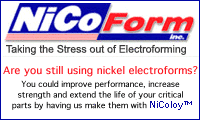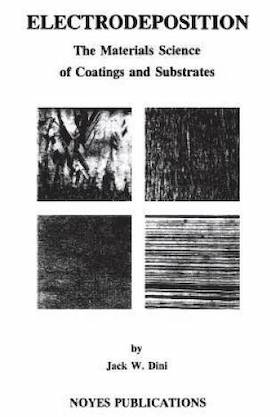
-----
Activating hardened H13 tool steel for plating
Does anyone have first-hand experience plating heavy (.010" and up) layers of sulfamate Ni onto hardened tool steels, for instance, H13, using a Woods strike? We recently ran into an adhesion problem with H 13. When we plate 0.010" of Ni onto a flat test part and pull the edge of the coating up with a pair of pliers (we deliberately leave an 'overhang' at the edge to make pulling possible), we can usually peel the deposit off the substrate. With much resistance, but it peels, although sometimes the Ni layer will start tearing. Is this a valid adhesion test? Some published papers suggest that a bond strength stronger than either of the metals can be achieved with a Woods strike, then we should not be able to peel the deposit away at all, should we? Anyhow, how would you activate hardened H13 for best adhesion to sulfamate Ni and what test method for adhesion strength would you suggest?
Regards,

"PlaterB" Berl Stein
NiCoForm, Inc.
Rochester, New York

1999
by Jack Dini

on eBay or Amazon
or AbeBooks
(affil link)
A. Hi Berl. There is a similar but more formal adhesion test done with an "Ollard Tester". You plate the end of a cylinder, then grind back the cylinder but not the plating, leaving an overhang. You drop the cylinder into a matching cylindrical hole, so the plating keeps it from falling through. Now you pull until something rips. There is a more versatile alternative called the "Modified Ollard Tester" that lets you test plating on plates as well as cylinders. Details can be found on letter 18002, "Hard Chrome Plating Bond Strength and Test Methods: Modified Ollard Test"
As for how to improve the adhesion, I'll have to pass -- but the quantitative limits of adhesion of Wood's Nickel are spelled out quite well in Dini's book "Electrodeposition" .

Ted Mooney, P.E.
Striving to live Aloha
finishing.com - Pine Beach, New Jersey
Ted is available for instant help
or longer-term assistance.
A. It is also important that you consider the steps used up to the Woods strike. After the normal soak, electroclean and acid dips, I have had very good success using an anodic etch in a sulfuric acid/ammonium bifluoride solution followed by a FRESH 30-50% HCl and then strike (although it's a little more involved than that -- if you need further information please contact me).
Rick Richardson, MSFDayton, Ohio
1999
Q, A, or Comment on THIS thread -or- Start a NEW Thread